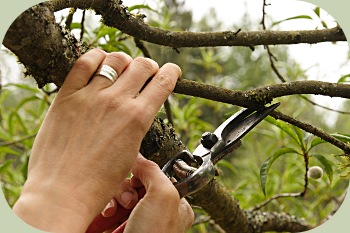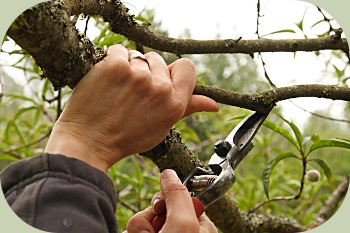Fruit Tree Pruning Instructions:
A Simple Approach
These simple fruit tree pruning instructions will help you bring health to your trees and encourage them to produce amazing fruit. Proper pruning can not only maintain and improve the health of fruit trees, but also encourage great fruit production and quality. Careful shaping and maintenance will help maximize yields of fruits.
The Basics
There are 3 basic aims of pruning: influencing the direction of shoot growth, ensuring structural growth and desired tree form; to remove the 3 "D's" (dead, diseased, or damaged wood) and prevent crowded or crossing branches, protecting the tree's health; and to maintain a good balance between cropping and growth. Pruning with these in mind will encourage your trees to fruit regularly, with properly spaced branches and fully developed fruit. It is vital in your approach that you follow good fruit tree pruning instructions for the trees you are working with.
Light Versus Hard Pruning
For older trees, the most important rule is to prune stronger growth lightly (or not at all) and prune weaker growth hard. Hard pruning overall will result in strong new growth but with few fruits. That means the root system has far fewer buds to serve, so these have a much greater growth potential, resulting in strong new shoots. Little or no pruning at all will leave a smaller ration of nutrients per bud. The amount of pruning must be varied depending on what is needed. Pruning weak growth hard will encourage them to ground into strong shoots. Pruning vigorous shoots lightly, or not at all, results in little growth, encouraging buds to develop into flower buds instead.
Types of Cuts
There are several different kinds of cuts that can be used while pruning fruit trees: thinning cut, heading cut and bench cut.
- A thinning cut removes an entire shoot back to a side shoot. This type of cut does not reinvigorate the tree.
- A heading cut is done to remove only the terminal portion of a shoot. This is done to promote growth on lower buds and several terminal buds below the cut.
- Bench cuts are used to remove vigorous upright shoots and bring it back to side branches that grow outward or relatively flat. This is used to open up the center of a tree and help spread the branches outward.

When to Prune
Two major periods of time to prune are in the winter and summer. In following good fruit tree pruning instructions, it helps to understand the difference between dormant pruning versus summertime pruning.
Dormant pruning is done in late winter to very early spring. This is done as late in winter as possible, to help minimize winter injury in colder areas. Younger trees should be pruned last, oldest trees first.
Summertime pruning is done to reduce tree growth. Generally it should be limited to cutting vigorous and upright growth from the current season using thinning cuts.
Be More Prepared For Your Next Outdoor Adventure!

Don't leave without knowing these six essential survival skills. Our free survival mini guide reveals the strategies of:
- Shelter & fire to prevent the number one cause of death
- Obtaining clean water to avoid life-threatening dehydration
- Common wild survival foods and other critical skills!

Further Fruit Tree Pruning Instructions
Keeping good fruit tree pruning instructions in mind, consider paying attention to the following things:
- Use the appropriate tools for the job and keep those tools properly maintained and sharpened
- Use pruning shears for limbs less than 1/2 inch in diameter, lopping shears for bigger cuts and a pruning saw for large mature limbs
- When cutting, do not leave a stub. Cut close to a bud, to a joint in the branch, or to the trunk. Pruning can be done just above a bud, where it is best to cut coming from the opposite side of the bud, at a 30-45 degree angle.
- Carefully prune the stems just above a pair of opposing buds or shoots. If shoots or buds are staggered, chose a strong one and make your cut just above it.
- Keep more vertical branches, cut horizontal ones.
- Remove any shoots from around the base of the tree.

Resources:
These basic fruit tree pruning instructions are applicable to many situations. To learn more about sustainable living skills like fruit tree pruning, check out our Permaculture Courses.
For further information you might enjoy:
Backyard Orchard Information at Deep Green Permaculture
Book: American Horticulture Society Pruning & Training
By the way, a big part of why we love homesteading & permaculture skills so much is because they are a natural extension of learning about wilderness survival (both fields are all about self-sufficiency and working with nature to satisfy needs). An understanding of survival not only helps you become a better permaculturist, it empowers you with life-saving outdoor skills to keep you safe when out in nature. Right now you can get a free copy of our mini survival guide here, where you'll discover six key strategies for outdoor emergencies, plus often-overlooked survival tips.

About the Author: Filip Tkaczyk is a periodic guest teacher at Alderleaf. He also wrote the field guide Tracks & Sign of Reptiles & Amphibians. Learn more about Filip Tkaczyk.
Return from Fruit Tree Pruning Instructions to Nature Skills Articles
Is The Essential Wilderness Survival Skills Course Right for You? Take the "Online Survival Training Readiness" Quiz
See for yourself if this eye-opening course is a good fit for you. It takes just a few minutes! Get your Survival Training Readiness Score Now!

Grow Your Outdoor Skills! Get monthly updates on new wilderness skills, upcoming courses, and special opportunities. Join the free Alderleaf eNews and as a welcome gift you'll get a copy of our Mini Survival Guide.

 The Six Keys to Survival: Get a free copy of our survival mini-guide and monthly tips!
The Six Keys to Survival: Get a free copy of our survival mini-guide and monthly tips!
Learn more